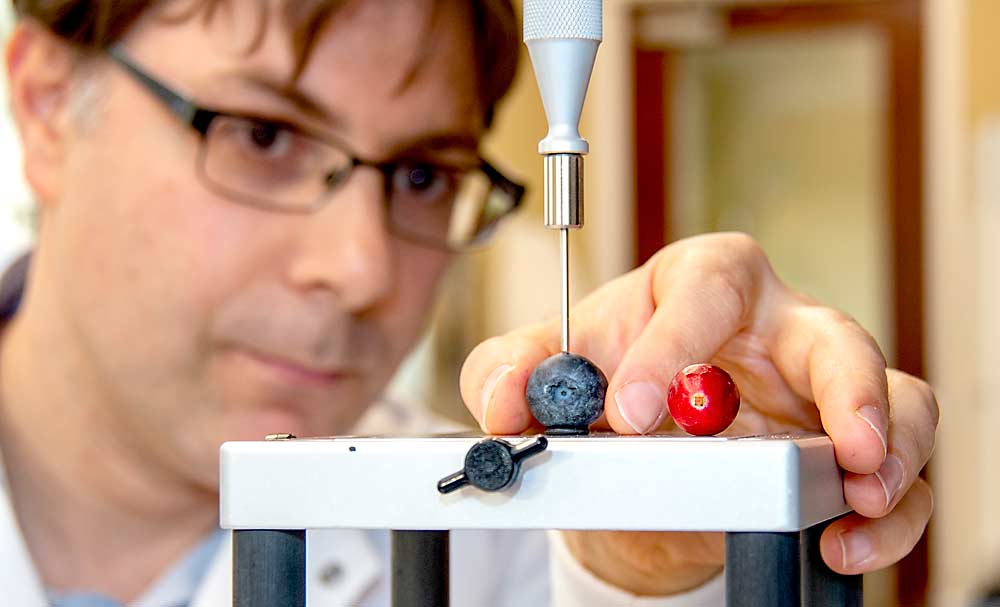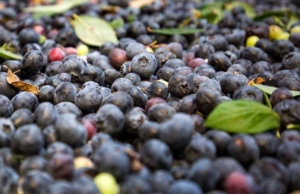
Consumers want to buy blueberries for their healthful properties, but they often discover that berry quality can be inconsistent from purchase to purchase. The blueberry industry needs cultivars that not only possess good fruit quality characteristics — including size, color, flavor, firmness and shelf life — but will express those characteristics over and over again, said Massimo Iorizzo, associate professor of plant genetics at North Carolina State University.
Iorizzo leads the Vaccinium Coordinated Agricultural Project, VacCAP, a new effort to improve the quality of Vaccinium fruit (which includes blueberry and cranberry) by bringing together researchers in the fields of breeding, genetics, food science and socioeconomics. The project’s chief goal is to find the fruit characteristics that consumers like, to understand the genetics behind those characteristics, and to develop a breeding framework around them, Iorizzo said.
“Both blueberry and cranberry are closely related, so working together among a network of Vaccinium breeders and sharing discoveries brought about through the use of more advanced, DNA-based tools has tremendous potential to lead to discoveries and selections that will translate into improved cultivars for growers,” said Lisa Wasko DeVetter, a Washington State University associate professor and co-leader of VacCAP’s extension team.
She said VacCAP follows a similar project for Rosaceae crops, RosBREED, in building a community of researchers and industry members with similar breeding goals, enabling the sharing of technology development and information.
RosBREED brought together a nationwide team of breeders and researchers working on pome fruit, stone fruit and berries. The effort received almost $25 million from the U.S. Department of Agriculture over 10 years, starting in 2009, for work focused on finding genetic markers for fruit quality traits and disease resistance that are now used by breeders across the country and beyond.
Initial work on the Vaccinium project started in 2016, when the USDA provided a $50,000 planning grant, allowing a team of scientists, led by Iorizzo, to survey the U.S. blueberry and cranberry industries to better understand their breeding priorities. They found that fruit quality is the main priority for both industries. Other priorities include disease resistance and the ability to withstand mechanical harvest, Iorizzo said.
VacCAP became official in September 2019, with $12.8 million from a combination of federal funding and matching funds from institutions and industry stakeholders. Members include breeders and geneticists from public and private institutions across the country, as well as scientists who specialize in the socioeconomic, food science and postharvest aspects of Vaccinium crops. The project also includes collaborators from New Zealand and Italy, he said.
By the time the project is slated to end in 2023, Iorizzo expects that a significant number of genomic resources and phenotyping methods will be delivered to blueberry and cranberry breeders and scientists. He also expects to expand knowledge on the relationship between DNA, fruit characteristics, fruit quality and consumer behavior. In the long term, he hopes the project will lead to an increase in the production of premium quality fruit, which will result in increased consumption of blueberry and cranberry products.
To achieve these goals, the project is organized into multiple teams of specialists, each with a different focus. Team leaders are members of the executive committee, which meets every two months. Iorizzo made special note of Chad Finn’s leadership role in the project. Finn, a longtime geneticist and berry breeder with USDA’s Agricultural Research Service, died unexpectedly in December 2019.
Iorizzo didn’t study blueberries before he came to NCSU. Once he familiarized himself with the industry, however, he discovered there were outstanding breeding programs across the country, but their focus was regional. VacCAP ties those programs together and gives them a national and international focus, he said.
The information generated by VacCAP’s activities will be in the public domain and available to all breeding programs, even international programs, said Jim Hancock, a member of the project’s executive committee. Hancock was a Michigan State University berry breeder and geneticist for nearly four decades before retiring in 2018, and he is currently manager of genomic research in support of breeding for Berry Blue, a private blueberry breeding company.
“(VacCAP) is a real boon for the whole blueberry industry,” he said.
—by Matt Milkovich







Leave A Comment